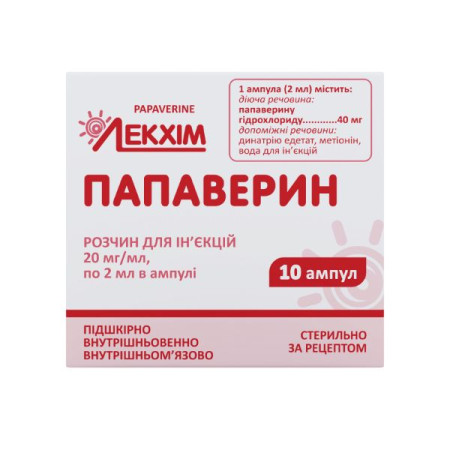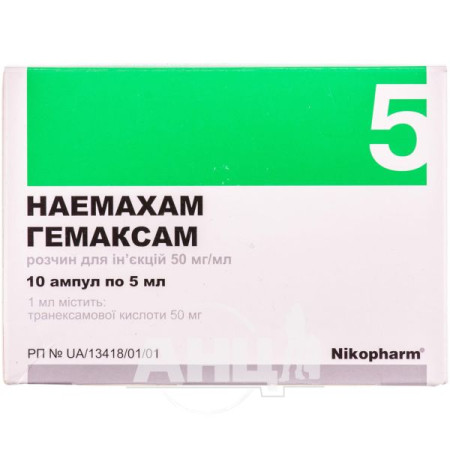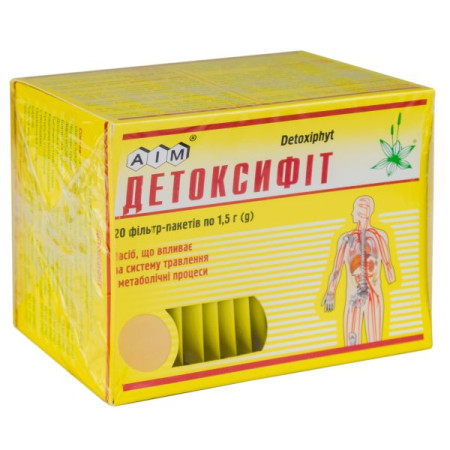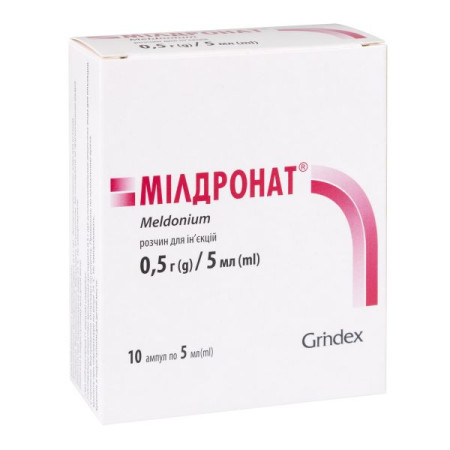Hemaxam solution for injection 50 mg/ml ampoule 5 ml No. 10
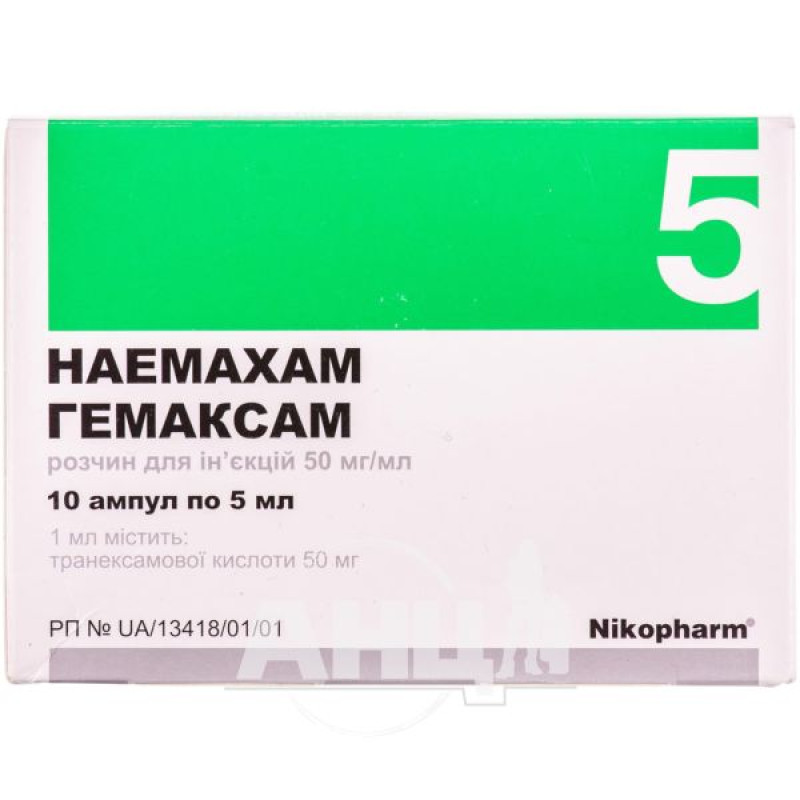
Pharmacological properties
Pharmacodynamics. Tranexamic acid is an antifibrinolytic agent that specifically inhibits the activation of profibrinolysin (plasminogen) and its conversion to fibrinolysin (plasmin). It has a local and systemic hemostatic effect in bleeding associated with increased fibrinolysis (platelet pathology, menorrhagia). Tranexamic acid also has anti-inflammatory, antiallergic, anti-infective and antitumor effects by inhibiting the formation of kinins and other active peptides involved in allergic and inflammatory reactions. The analgesic activity of tranexamic acid has been experimentally confirmed, as well as the ability to enhance the analgesic effect of opiates.
Pharmacokinetics. Distributed in tissues relatively evenly (except for cerebrospinal fluid, where the concentration is 1/10 of the plasma); penetrates through the blood-brain barrier and placental barrier, into breast milk (≈1% of the concentration in maternal plasma). Determined in sperm, where it reduces fibrinolytic activity, but does not affect sperm migration. The initial volume of distribution is 9-12 l. 3% binds to blood plasma proteins (profibrinolysin).
The concentration of antifibrinolytics in various tissues is maintained for 17 hours, in blood plasma - up to 7-8 hours.
A small part is metabolized. The concentration/time curve has a triphasic shape with T½ in the terminal phase - 2 hours. Total renal clearance is equal to plasma (7 l / h). Excreted by the kidneys (the main route is glomerular filtration): about 95% in unchanged form during the first 12 hours.
Two metabolites of tranexamic acid have been identified (N-acetylated and deaminated). In cases of impaired renal function, there is a risk of accumulation of tranexamic acid.
Indication
Bleeding or risk of bleeding with increased fibrinolysis, both generalized (bleeding during operations and in the postoperative period, postpartum hemorrhage, manual separation of the placenta, chorionic detachment, bleeding during pregnancy, malignant neoplasm of the pancreas and prostate, hemophilia, hemorrhagic complications of fibrinolytic therapy, thrombocytopenic purpura, leukemia, liver disease, previous therapy with streptokinase) and local (uterine, nasal, pulmonary, gastrointestinal bleeding, hematuria, bleeding after prostatectomy, conization of the cervix for carcinoma, tooth extraction in patients with hemorrhagic diathesis). surgical interventions on the urinary bladder. surgical manipulations in the case of a systemic inflammatory reaction (sepsis, peritonitis, pancreatic necrosis, severe and moderate gestosis, shock of various etiologies and other critical conditions).
Application
Hemaxam is administered intravenously (drip, jet).
The dosage regimen is individual and depends on the clinical situation.
In case of generalized fibrinolysis, it is administered in a single dose of 15 mg/kg of body weight every 6-8 hours, the rate of administration is 1 ml/min.
For local fibrinolysis, it is recommended to use the drug at a dose of 200-500 mg 2-3 times a day.
During prostatectomy or bladder surgery, 1 g is administered during the operation, then 1 g every 8 hours for 3 days, after which the tablet form is switched to the treatment until the macrohematuria disappears.
If there is a high risk of bleeding during a systemic inflammatory reaction, it is recommended to use the drug at a dose of 10-11 mg/kg 20-30 minutes before surgery.
Patients with coagulopathy are administered the drug at a dose of 10 mg/kg before tooth extraction, and after tooth extraction, oral administration of tranexamic acid in tablet form is prescribed.
In case of impaired renal excretory function, correction of the dosage regimen is necessary depending on the concentration of creatinine in the blood:
120-250 μmol/l is prescribed 10 mg/kg 2 times a day; 250-500 μmol/l - 10 mg/kg 1 time a day; 500 μmol/l - 5 mg/kg 1 time a day.Children: The maximum single dose should not exceed 10 mg/kg body weight. The maximum daily dose is 20 mg/kg.
Contraindication
Thromboembolic diseases in the past; high risk of thrombosis; macroscopic hematuria; coagulopathy due to diffuse intravascular coagulation (DIC) without significant activation of fibrinolysis; myocardial infarction; subarachnoid hemorrhage; severe renal failure; color vision impairment; hypersensitivity to the drug.
Side effects
On the part of the immune system: allergic reactions (rash, itching, urticaria).
On the part of the digestive system: anorexia, nausea, vomiting, heartburn, diarrhea.
From the cardiovascular system: tachycardia, chest pain, arterial hypotension (with rapid intravenous administration).
On the part of the organ of vision: impaired color vision, blurred vision.
From the blood and lymphatic system: thrombosis or thromboembolism (the risk of development is minimal).
General disorders: dizziness, weakness, drowsiness.
Special instructions
To avoid AG, the drug should be administered slowly, at a dose of no more than 1 mg/min.
Tranexamic acid is excreted mainly in the urine unchanged, therefore, in patients with impaired renal function, it is recommended to reduce the dose and the number of injections. For intravenous administration of the drug, dose adjustment is required (see Method of administration).
Cases of venous and arterial thrombosis or thromboembolism have been reported in patients taking tranexamic acid. In addition, tranexamic acid should not be used in patients with thromboembolic disease, as there is an increased risk of venous or arterial thrombosis.
Tranexamic acid is not recommended for use concurrently with Factor IX complex or anti-inhibitor coagulation complexes, as the risk of thrombosis is increased.
Concomitant therapy with chlorpromazine and tranexamic acid in patients with subarachnoid hemorrhage may lead to cerebral vasospasm and cerebral ischemia, and a decrease in cerebral blood flow is also possible.
During treatment, observation by an ophthalmologist for several days is necessary to monitor visual acuity, visual fields and color vision, and to examine the fundus due to possible occlusion of retinal vessels and the central retinal vein.
Use during pregnancy and breastfeeding. There are no data on adequate controlled clinical studies of the safety of tranexamic acid during pregnancy. However, there is evidence of the absence of teratogenic and embryotoxic effects. The use of tranexamic acid for hemostatic therapy in the I-II trimester of pregnancy with the threat of miscarriage is described, which allows you to quickly eliminate the threat of termination of pregnancy and contributes to the successful course of pregnancy.
The drug is used during childbirth and cesarean section in normal doses.
Tranexamic acid passes into breast milk in small amounts (0.01%). The drug can be prescribed during breastfeeding.
Ability to influence the reaction rate when driving vehicles or working with other mechanisms. When using the drug Hemaxam in normal doses, dizziness and hypotension may occur, as well as deterioration in the quality of color perception and clarity of vision, therefore, during the treatment period, driving vehicles or working with complex mechanisms that require concentration of attention and speed of reaction should be avoided.
Interactions
Due to limited data, highly active prothrombin complex and other antifibrinolytic agents, antiinhibitory coagulation complexes should not be used concomitantly with tranexamic acid. Tranexamic acid can be mixed with most solutions (electrolytes, glucose, antishock solutions).
Heparin can be added to intravenous drip administration.
Concomitant therapy with chlorpromazine and tranexamic acid in patients with subarachnoid hemorrhage may lead to cerebral vasospasm and cerebral ischemia, and a decrease in cerebral blood flow is also possible.
Tranexamic acid is incompatible with urokinase, norepinephrine bitartrate, desoxyepinephrine hydrochloride, dipyridamole, diazepam.
Incompatibility. Hemaxam is incompatible with blood products, solutions containing penicillin, hypertensive agents (norepinephrine, desoxyepinephrine hydrochloride), tetracyclines, dipyridamole, diazepam.
Incompatible with urokinase, except when used as an antidote after an overdose of the latter.
Overdose
In case of overdose, nausea, vomiting, and orthostatic hypotension are possible.
Treatment is symptomatic, forced diuresis is indicated. It is necessary to maintain water-salt balance.
Storage conditions
In the original packaging at a temperature not exceeding 25 °C.
There are no reviews for this product.
There are no reviews for this product, be the first to leave your review.
No questions about this product, be the first and ask your question.




